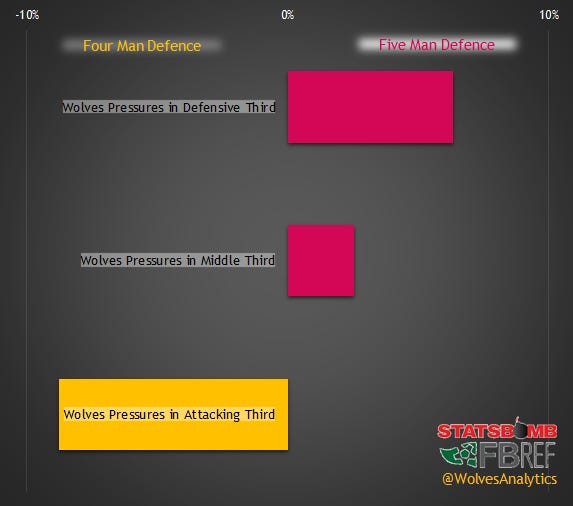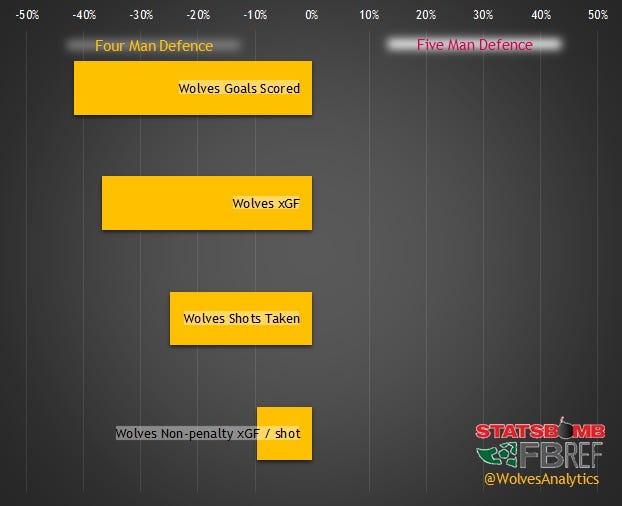Analytic Review of 2020/21 - Part 4: Five at the back, or Pace in Attack?
For the final part of the 2020/21 review, I look at the success of Wolves move towards a back 4.
For the first 166 matches of Nuno’s reign, Wolves played three centre backs with two wingbacks. It was a defensive system that got the best out of non-specialist centre-halves and fullbacks who enjoy getting forward. But then it all changed. On 23rd November 2020, to the surprise of everyone, Wolves faced Southampton with a four-man defence and took 20 shots. This was the most in a league game since the 1-1 draw away at Arsenal more than a year before. The dawn of a new era. Kind of. Over the next 29 matches, we used a back-four 13 more times to mixed results.
If you missed the Parts 1, 2 and 3 of the WolvesAnalytics review of the season, catch them here:
So, let’s examine how the results and style of play differed depending on the defence employed in 2020/21.
Something to note - this is using league games only, and matches are categorised by the starting formation. So, in the 3-3 draw with Brighton, we started with a 4-2-3-1 formation before switching to 5-4-1 on the hour mark. So all data from that match is categorised as ‘back-4’. And the graphs all show the percentage difference between a back-4 and back-5.
So, given that it’s the defence that we’re looking at let us start with the defensive numbers.
As you know, we concede more goals with a back-4; 1.7 per game compared to 1.2 with a back-5 - that difference adds up to 21 more goals conceded throughout a season. But, the expected goals conceded is a lot closer (1.25 v 1.18 xGA, just 2.5 goals for a complete season).
As might be expected, the back-5 gave up more shots but of lower quality. This is very much how we have always defended under Nuno - sit deep and give up lots of easily blocked or saved shots from poor positions.
This is explained when looking at where we pressed and where the opposition passed the ball. The four-man defence system pressed a lot higher up the pitch, generally forcing the opponent back into their half.
But, once a team had bypassed the press, it was straightforward to get the ball into our penalty area.
In comparison, the five-man defence was happy for the opposition to have the ball but then kept the ball out of our penalty area.
If the back-5 was challenging to pass through, that wasn’t the case when it came to dribbling. But, of course, we don’t know the reasons for this - it could be that the back-4 system was so easy to pass through that teams did not need to try dribbling. Or, it could very much be based on the quality of opposition - we tended to play a back-5 against the better teams.
The back-4 perhaps did not bring out the best in the goalkeeper.
Interestingly, Rui touched the ball further from goal and outside the penalty area more often on average when playing behind a back-5 than a back-4. This raises two possibilities: first, Rui may have struggled when playing the higher line of the back-4. He’s not the most adept at being a sweeper keeper. But also, the struggles that the back-5 had; in that system, he shouldn't have to be outside the penalty area. Second, he also struggled when saving shots in the four-man defence - conceded 4.6 more goals than expected from the shots' quality. In comparison, when playing behind a back-5, he stopped 1.3 goals more than would be expected. This very much raises questions regarding Rui’s ability to play in a more expansive system.
So that’s the defence. Let’s now take a look at the attack.
It won’t surprise you to know that the back-4 led to far more goals being scored. Moreover, when playing with a back-4, we created more chances and, crucially, a better quality of chance.
The back-4 saw us have more possession (51.8% v 47.8%), and then we were able to get the ball forward a lot easier. As a result, we were far less likely to pass the ball around at the back and instead got the ball forward a lot quicker. Indeed with a back-4, on average, we touched the ball 24 times a match in the oppositions penalty area 24 time, compared to 17.5 with a back-5.
So, how did we get the ball forward? Well, we certainly passed the ball better in a back-4.
And we dribbled more. Essentially, we were far better at moving the ball forward with a back-4. The five-man defence was far more reliant on carrying the ball forward rather than passing it.
Let’s finish by putting some of this together. After all, attack and defence do not occur on their own.
We won more points with the back-5, and a large part of this is because of the defence - we conceded 1.2 goals per game against 1.7 goals per game with a back-4. But this doesn’t tell the whole story. The five-man defence gave up more shots and more expected goals. So it wouldn't have needed a massive change in fortunes for the defensive record of the back-4 to be as good as the back-5.
Food for thought going into next season.









